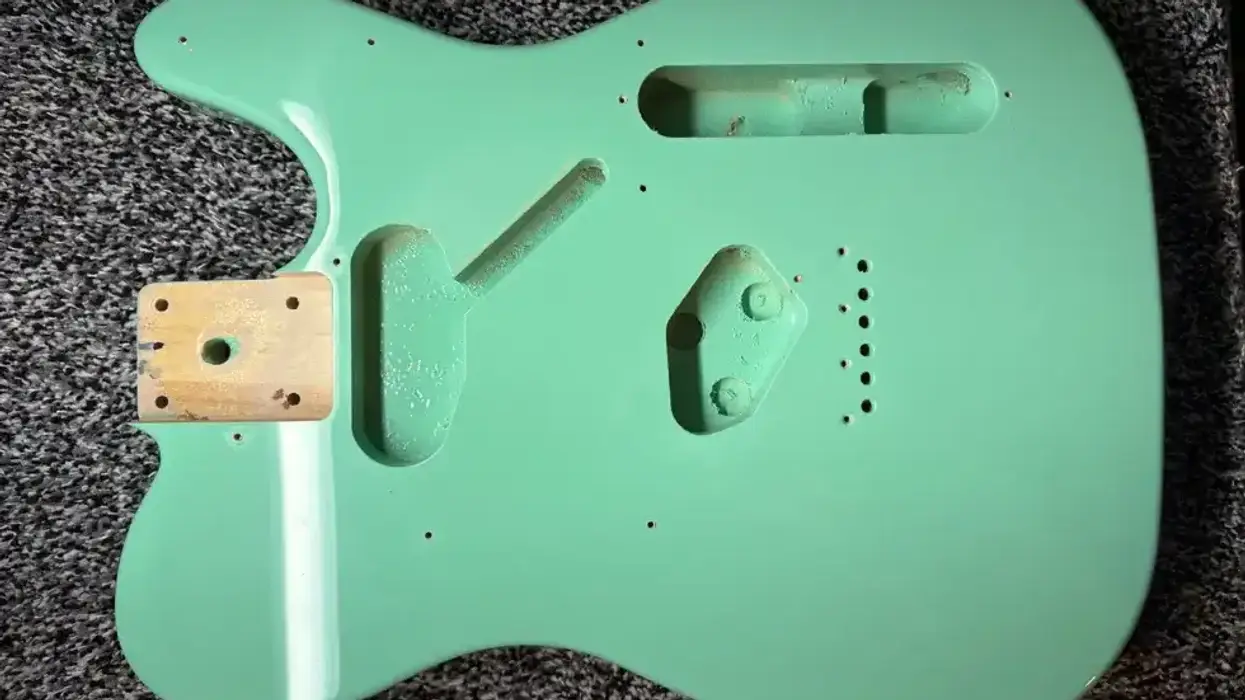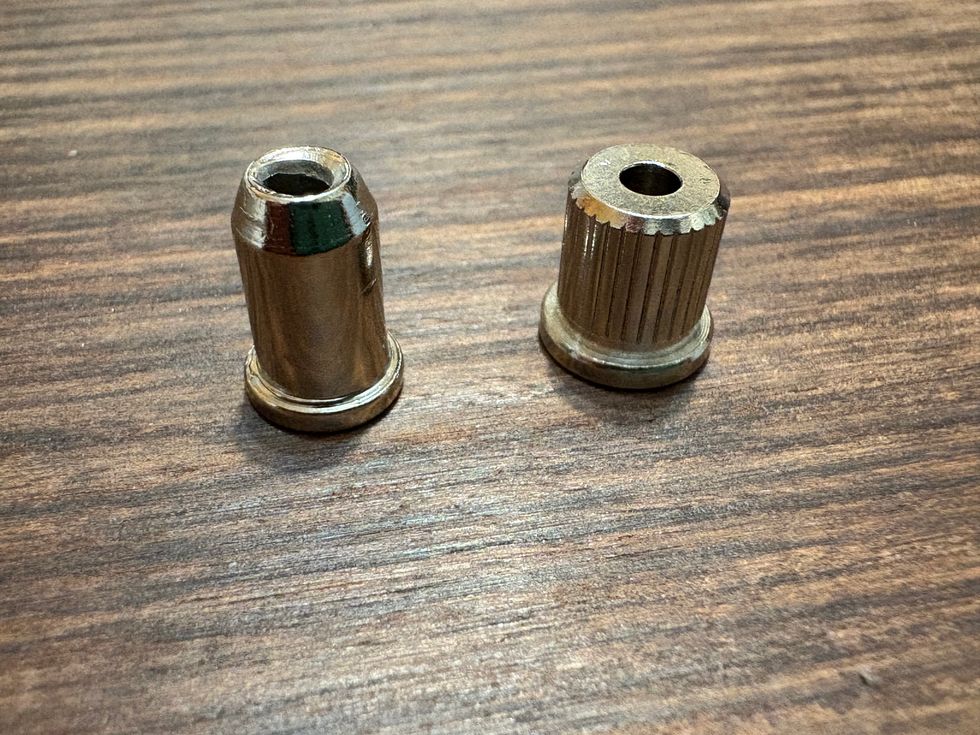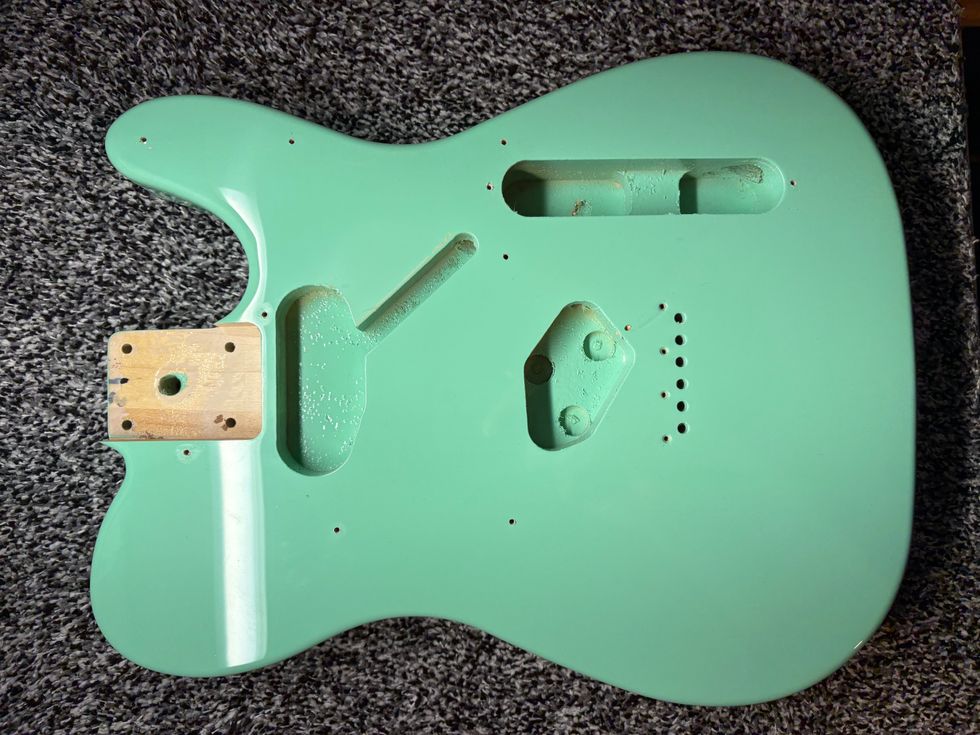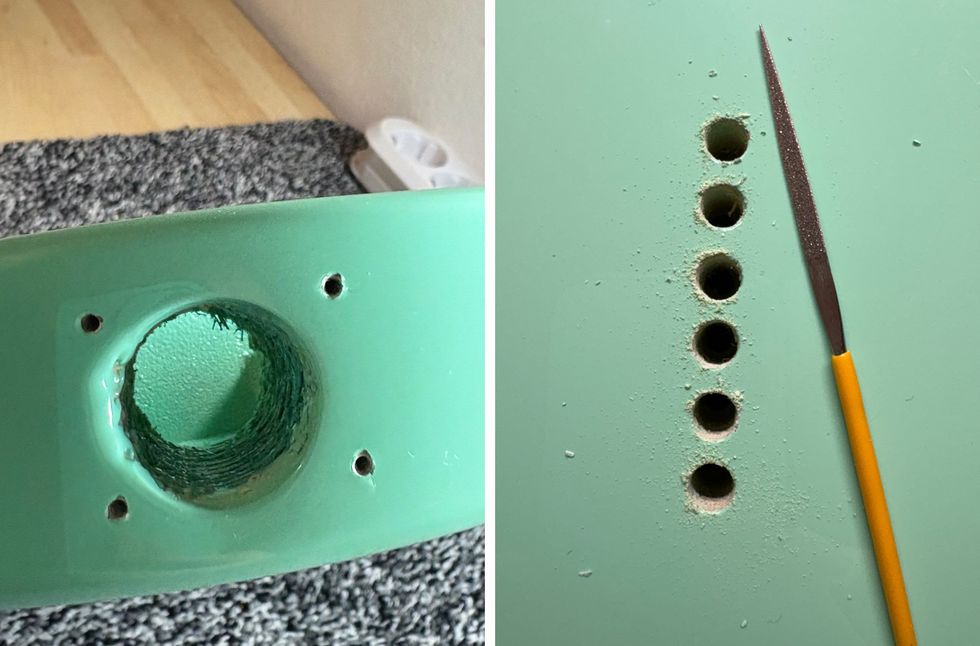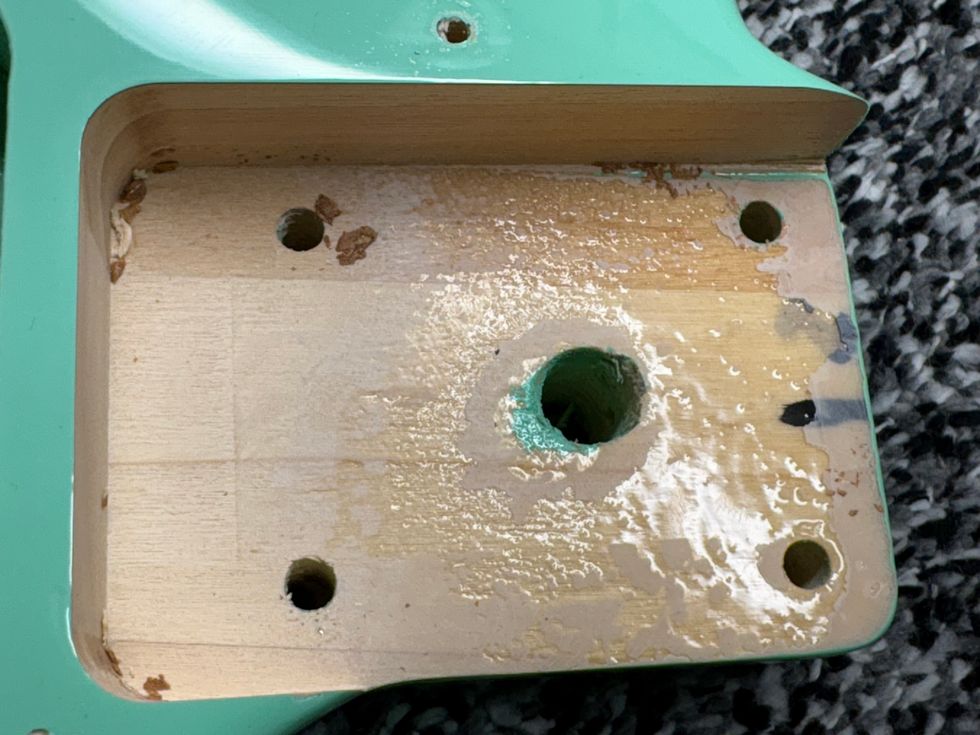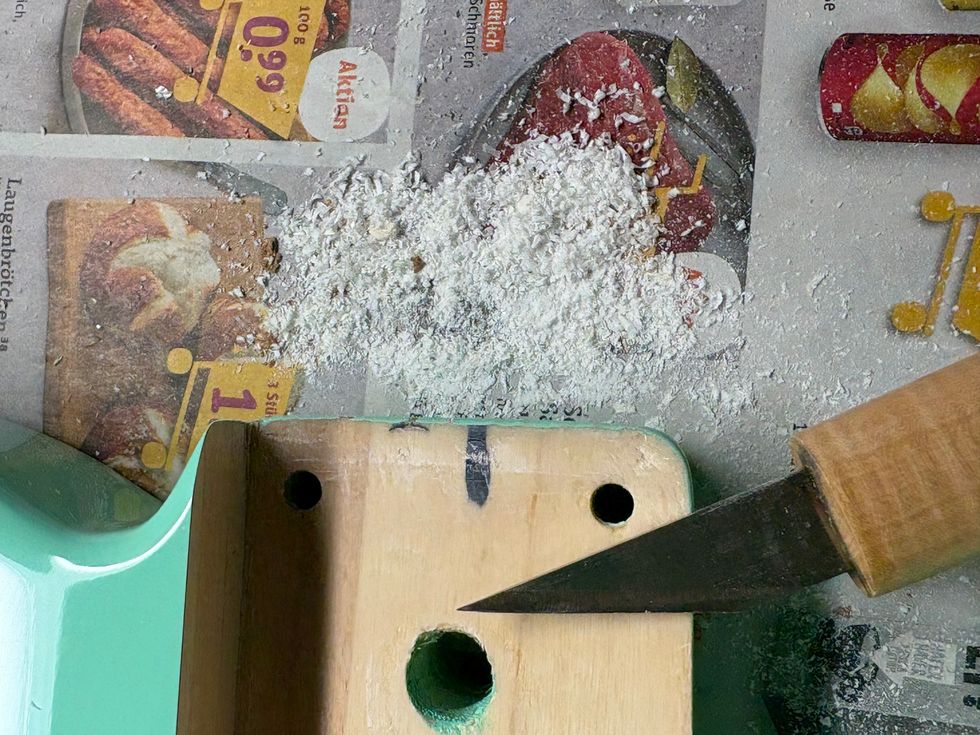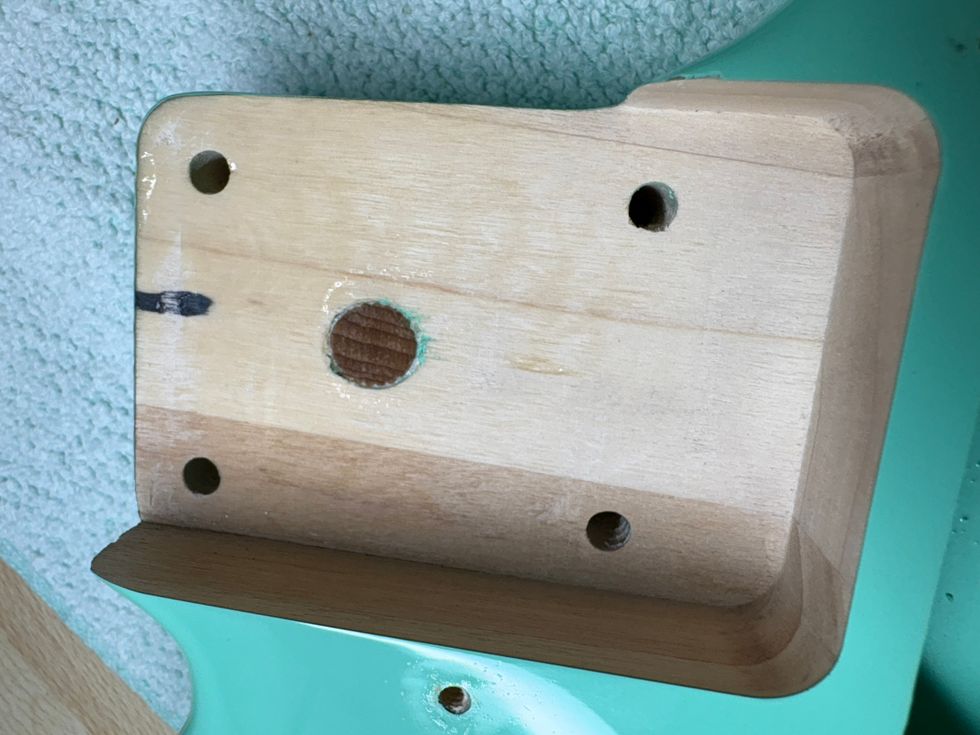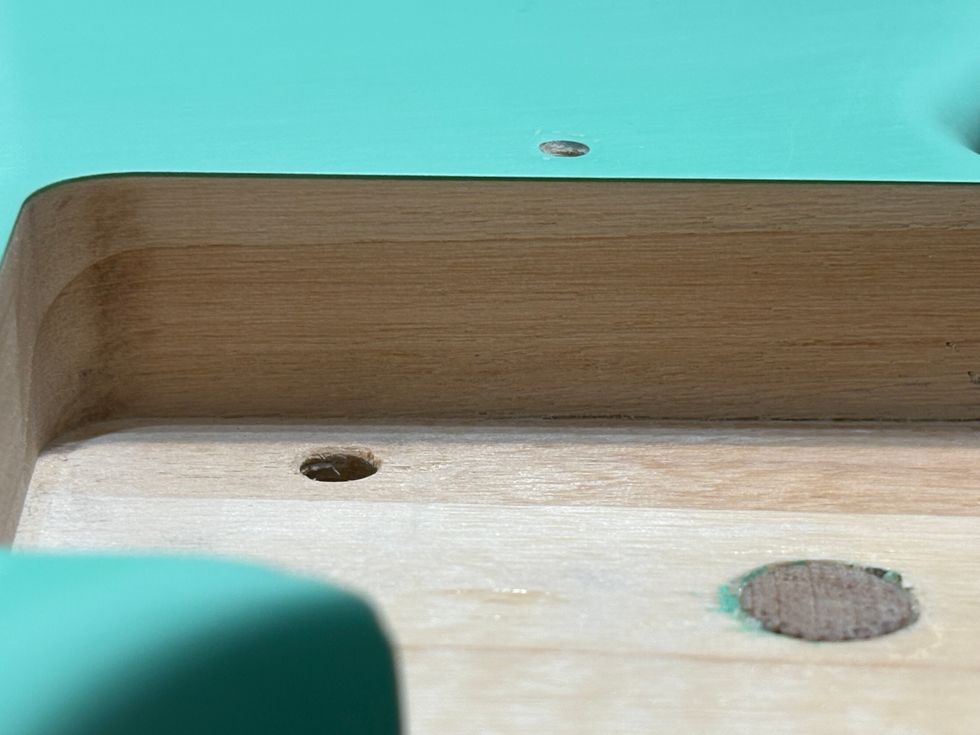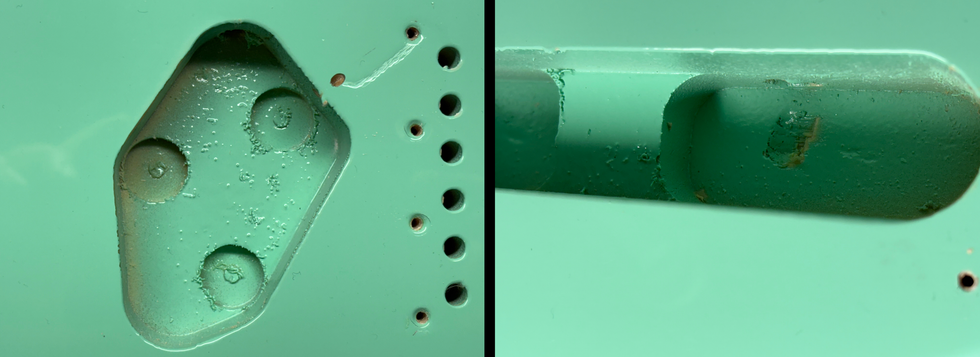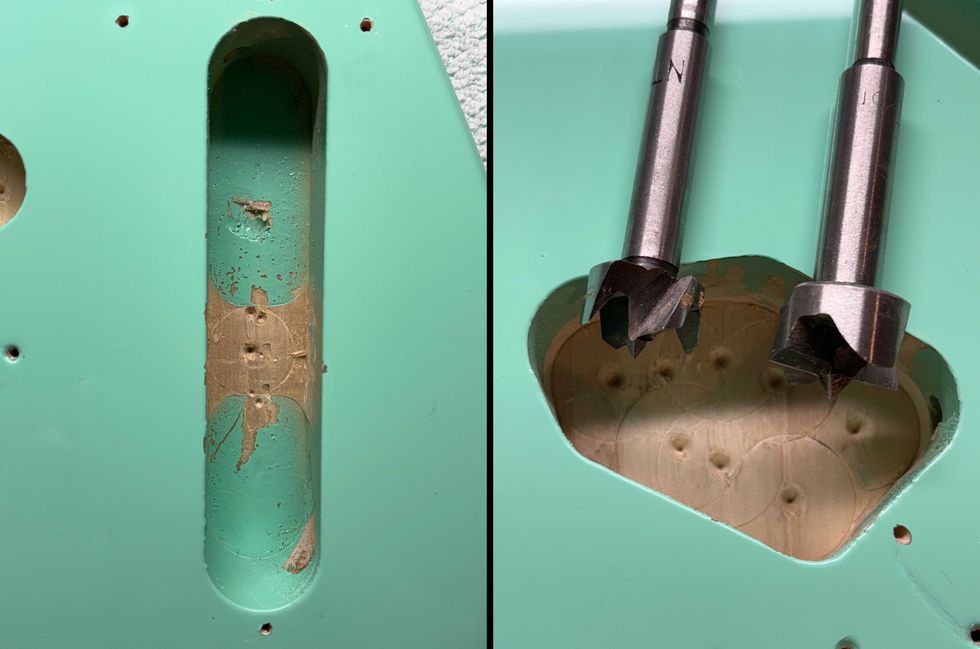If you’re into cooking, you
probably know about roux.
It’s a simple mixture of fat—usually butter—combined with
flour and used for thickening
up sauces. Also, many sauce
recipes (especially Chinese
styles), will call for adding
cornstarch near the end of the
cooking process to help thicken
things up. I certainly don’t recommend
pouring roux or cornstarch
into your computer or
hard drive to thicken your guitar
tracks, but there are some
things we can do to add mass
to our tones in the studio.
Get it right from the start.
It’s much easier to capture a fat-sounding track if you have a good, thick guitar tone coming out of your amplifier. It’s worth taking the time to find the right combination of guitar, amp, and pedals to ensure you have a thick tone at the source. For me, “thick” usually means humbuckers or P-90s, but you can also get fat sounds out of a guitar equipped with Fender-style single-coils, if the amp provides some additional girth. I find that a resonant instrument, such as a lightweight solidbody, a semi-hollow or chambered axe, or a hollowbody gets a fatter sound than a heavier, more inert solidbody.
Capture the sound well.
Revisit the past few installments of Guitar Tracks at premierguitar.com, and you’ll find many suggestions for mic’ing techniques and mic selection. Jimmy Page got huge tones out of a tiny Supro amp and a Tele, and one trick he used was distant mic’ing. On those early Zep albums, he lived by the old studio maxim, “distant makes depth.” So go ahead and try mixing in room mics along with the close mics on your amps.
Compare and contrast.
When you’re arranging your songs, mix in some thinner, lighter sounds along with your fat and heavy sounds, giving each one its time in the spotlight. If you follow a thin, light tone with a fat, heavy one, the latter will sound even fatter and thicker than it would if it was surrounded by other fat tones.
Split it.
Create a stereo version of a mono sound. A common way to do this is to use a very short delay—try between 12 ms and 24 ms with no feedback or regeneration. Just place the dry sound on one side of the stereo field and pan the delayed sound to the opposite side.
There are some cool variations of this technique, including the old Van Halen trick of panning the dry sound to one side, and its reverbed counterpart to the other. You could also go dry on one side, with chorusing, flanging, or phasing on the other. Try copying your track and placing the original on one side, with the copy on the other, nudged a few milliseconds earlier or later. Then cut some frequencies and boost others slightly with a multi-band equalizer on the original track. On the copied track, cut and boost the opposite frequencies by the same amounts.
Double up.
Record a pass of your guitar to one track and then record a second pass to a second track. Playing the second track as close to the first as possible will result in a big sound. Varying the second track slightly (not going for an exact duplicate of the first) can give you a different, bigger sound. Then pan the two tracks opposite one another in the stereo field. Instant thickener!
A variation on this technique is using a completely different guitar voicing for the second track—maybe a totally different guitar and amp. You could even play an octave up or down on the second track. Fine-tune the two sounds so that they complement each other in the mix.
Layer it.
Why stop with one double? You can add more doubled tracks on top of the original, be it multiple octave-up versions, octave-down versions, and so on. Keep in mind that there is a point of diminishing returns—the sound can get so washy that you lose presence.
The trick is careful mixing. I once created a huge guitar tone by playing the basic track and panning it to the center, and following that by playing a double for each side. These were mixed back in volume from the original. Then I played an octave double—using an inverted chord voicing—twice. These two tracks were also mixed way back in volume compared to the original. The result? A full, thick sound that didn’t come across as overly processed or multi-tracked—the original track carried the day. The doubles were there for added heft, harmonic content, depth, and width.
Pitch it.
Place your dry guitar track in the center of the stereo field and use an effects send to run it to a stereo pitch-shifting plug-in. Set the left side of the pitch shifter 3 to 5 cents sharp and the right side 3 to 5 cents flat, and then mix in behind the dry signal to taste. This creates a cool, chorus-like sound, but thicker and sans the warbly motion. Don’t shift too far, or the effected tracks will sound out of tune. Another option is to place your dry signal on one side of the stereo field, and both pitch-shifted versions (sharp and flat) on the other side of the stereo field.
Combine and conquer.
There is no rule that says you can only use one of these techniques to craft your massive guitar track. Try combining effects processing with doubling (and varied inversions and voicings) to achieve a huge tone. Using these techniques, your tracks will bulk up nicely and fill out your songs more than ever before. There is simply no reason to suffer with thin, wimpy guitar tracks in your productions!
 Mitch Gallagher is
the former editor in chief of
EQ magazine. He’s written
more than 1000 articles
and six books on recording
and music technology, and
has released an instructional
DVD on mastering. His upcoming book is
entitled Guitar Tone: Pursuing the Ultimate
Electric Guitar Sound. To learn more, visit
mitchgallagher.com.
Mitch Gallagher is
the former editor in chief of
EQ magazine. He’s written
more than 1000 articles
and six books on recording
and music technology, and
has released an instructional
DVD on mastering. His upcoming book is
entitled Guitar Tone: Pursuing the Ultimate
Electric Guitar Sound. To learn more, visit
mitchgallagher.com.
Get it right from the start.
It’s much easier to capture a fat-sounding track if you have a good, thick guitar tone coming out of your amplifier. It’s worth taking the time to find the right combination of guitar, amp, and pedals to ensure you have a thick tone at the source. For me, “thick” usually means humbuckers or P-90s, but you can also get fat sounds out of a guitar equipped with Fender-style single-coils, if the amp provides some additional girth. I find that a resonant instrument, such as a lightweight solidbody, a semi-hollow or chambered axe, or a hollowbody gets a fatter sound than a heavier, more inert solidbody.
Capture the sound well.
Revisit the past few installments of Guitar Tracks at premierguitar.com, and you’ll find many suggestions for mic’ing techniques and mic selection. Jimmy Page got huge tones out of a tiny Supro amp and a Tele, and one trick he used was distant mic’ing. On those early Zep albums, he lived by the old studio maxim, “distant makes depth.” So go ahead and try mixing in room mics along with the close mics on your amps.
Compare and contrast.
When you’re arranging your songs, mix in some thinner, lighter sounds along with your fat and heavy sounds, giving each one its time in the spotlight. If you follow a thin, light tone with a fat, heavy one, the latter will sound even fatter and thicker than it would if it was surrounded by other fat tones.
Split it.
Create a stereo version of a mono sound. A common way to do this is to use a very short delay—try between 12 ms and 24 ms with no feedback or regeneration. Just place the dry sound on one side of the stereo field and pan the delayed sound to the opposite side.
There are some cool variations of this technique, including the old Van Halen trick of panning the dry sound to one side, and its reverbed counterpart to the other. You could also go dry on one side, with chorusing, flanging, or phasing on the other. Try copying your track and placing the original on one side, with the copy on the other, nudged a few milliseconds earlier or later. Then cut some frequencies and boost others slightly with a multi-band equalizer on the original track. On the copied track, cut and boost the opposite frequencies by the same amounts.
Double up.
Record a pass of your guitar to one track and then record a second pass to a second track. Playing the second track as close to the first as possible will result in a big sound. Varying the second track slightly (not going for an exact duplicate of the first) can give you a different, bigger sound. Then pan the two tracks opposite one another in the stereo field. Instant thickener!
A variation on this technique is using a completely different guitar voicing for the second track—maybe a totally different guitar and amp. You could even play an octave up or down on the second track. Fine-tune the two sounds so that they complement each other in the mix.
Layer it.
Why stop with one double? You can add more doubled tracks on top of the original, be it multiple octave-up versions, octave-down versions, and so on. Keep in mind that there is a point of diminishing returns—the sound can get so washy that you lose presence.
The trick is careful mixing. I once created a huge guitar tone by playing the basic track and panning it to the center, and following that by playing a double for each side. These were mixed back in volume from the original. Then I played an octave double—using an inverted chord voicing—twice. These two tracks were also mixed way back in volume compared to the original. The result? A full, thick sound that didn’t come across as overly processed or multi-tracked—the original track carried the day. The doubles were there for added heft, harmonic content, depth, and width.
Pitch it.
Place your dry guitar track in the center of the stereo field and use an effects send to run it to a stereo pitch-shifting plug-in. Set the left side of the pitch shifter 3 to 5 cents sharp and the right side 3 to 5 cents flat, and then mix in behind the dry signal to taste. This creates a cool, chorus-like sound, but thicker and sans the warbly motion. Don’t shift too far, or the effected tracks will sound out of tune. Another option is to place your dry signal on one side of the stereo field, and both pitch-shifted versions (sharp and flat) on the other side of the stereo field.
Combine and conquer.
There is no rule that says you can only use one of these techniques to craft your massive guitar track. Try combining effects processing with doubling (and varied inversions and voicings) to achieve a huge tone. Using these techniques, your tracks will bulk up nicely and fill out your songs more than ever before. There is simply no reason to suffer with thin, wimpy guitar tracks in your productions!
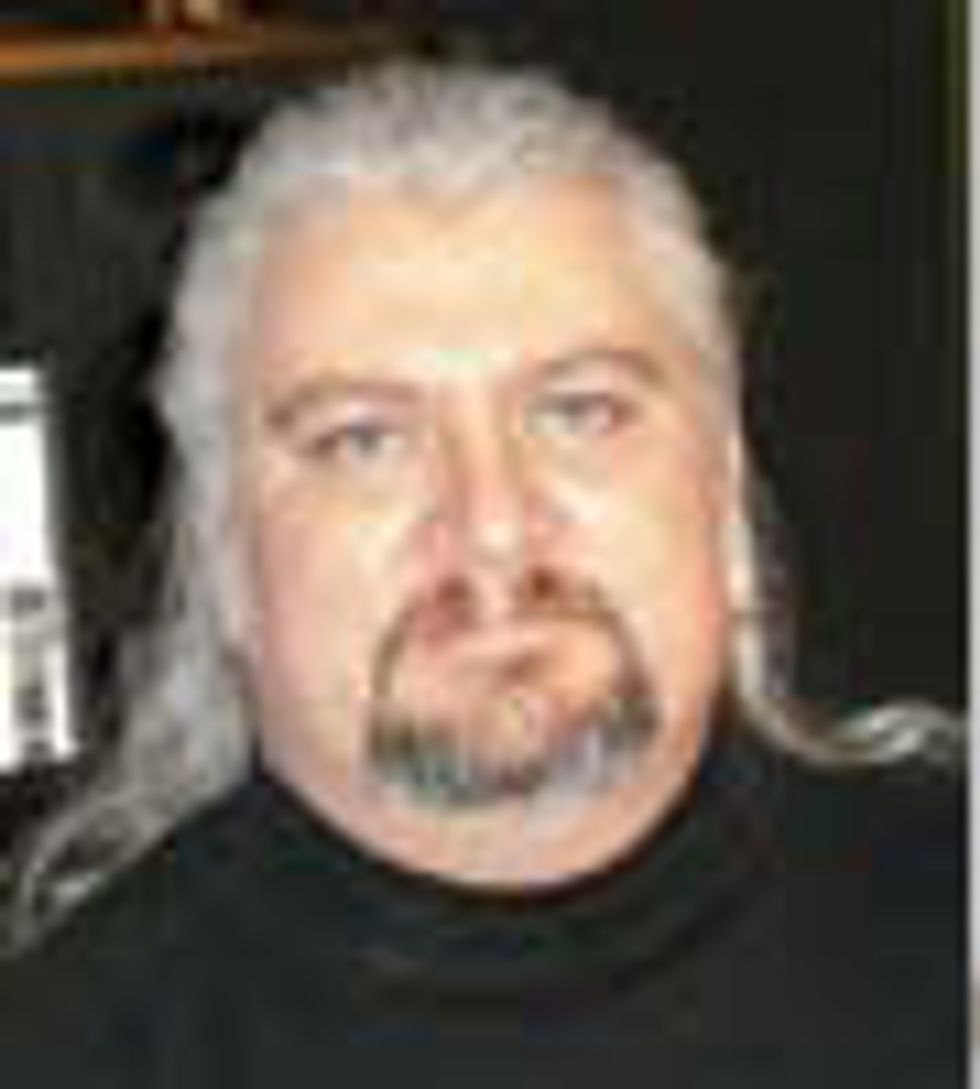 Mitch Gallagher is
the former editor in chief of
EQ magazine. He’s written
more than 1000 articles
and six books on recording
and music technology, and
has released an instructional
DVD on mastering. His upcoming book is
entitled Guitar Tone: Pursuing the Ultimate
Electric Guitar Sound. To learn more, visit
mitchgallagher.com.
Mitch Gallagher is
the former editor in chief of
EQ magazine. He’s written
more than 1000 articles
and six books on recording
and music technology, and
has released an instructional
DVD on mastering. His upcoming book is
entitled Guitar Tone: Pursuing the Ultimate
Electric Guitar Sound. To learn more, visit
mitchgallagher.com.



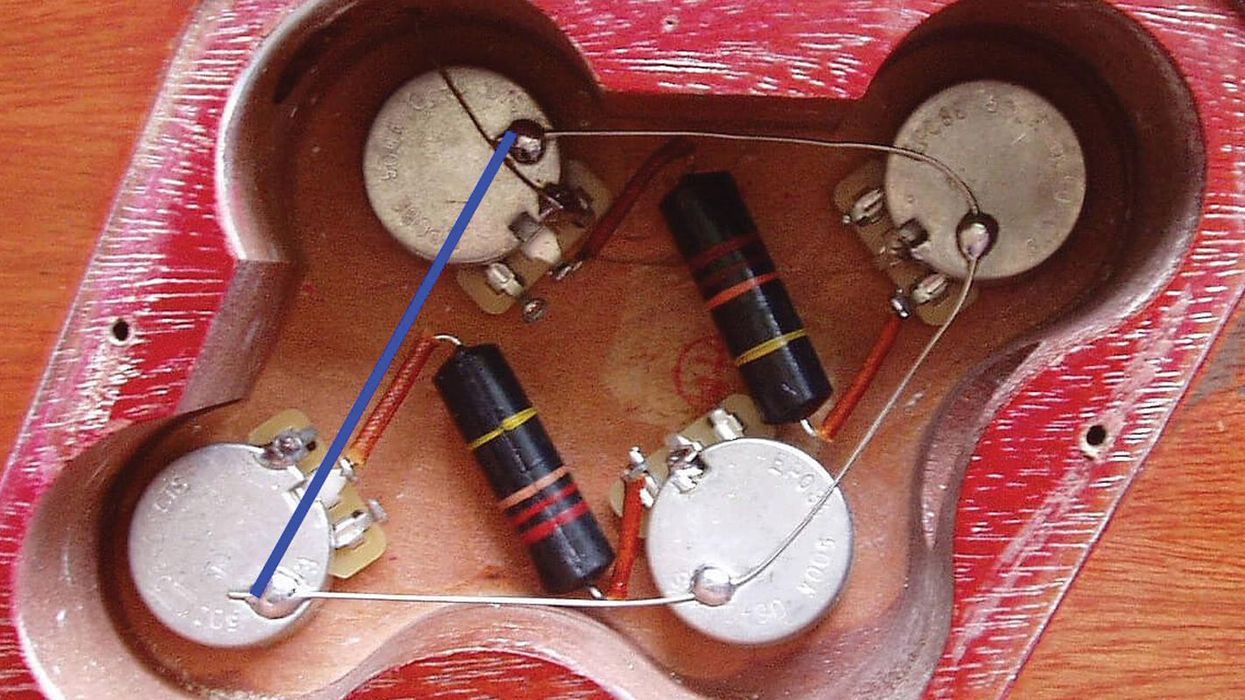
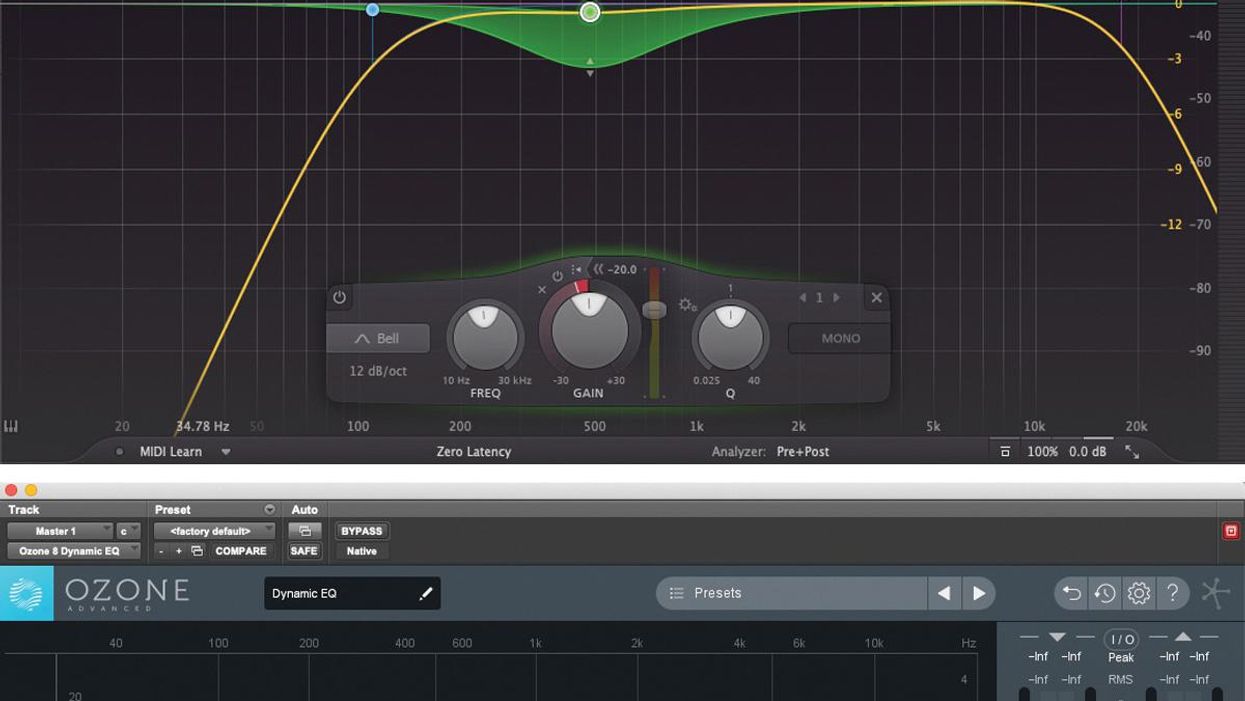





![Devon Eisenbarger [Katy Perry] Rig Rundown](https://www.premierguitar.com/media-library/youtube.jpg?id=61774583&width=1245&height=700&quality=70&coordinates=0%2C0%2C0%2C0)




 The Allparts team at their Houston warehouse, with Dean Herman in the front row, second from right.Photo by Enrique Rodriguez
The Allparts team at their Houston warehouse, with Dean Herman in the front row, second from right.Photo by Enrique Rodriguez
